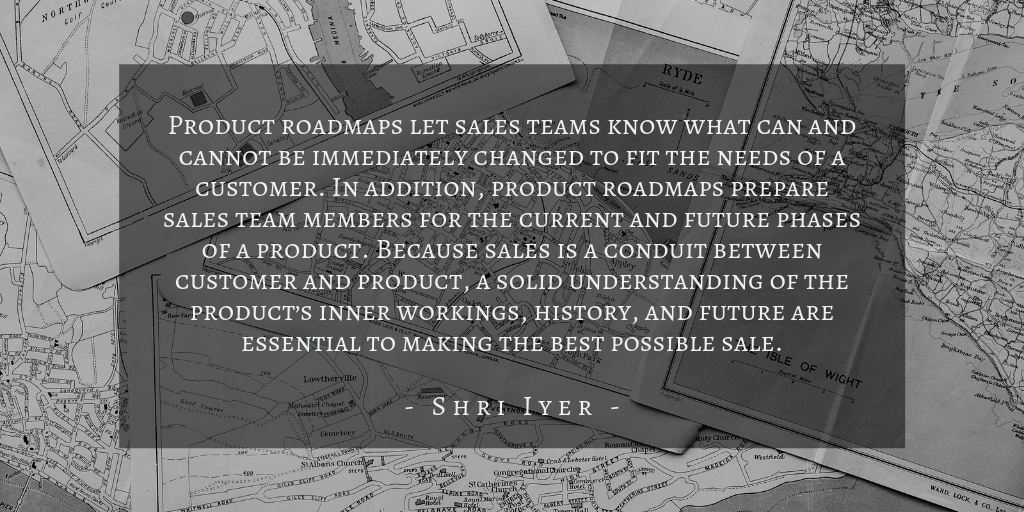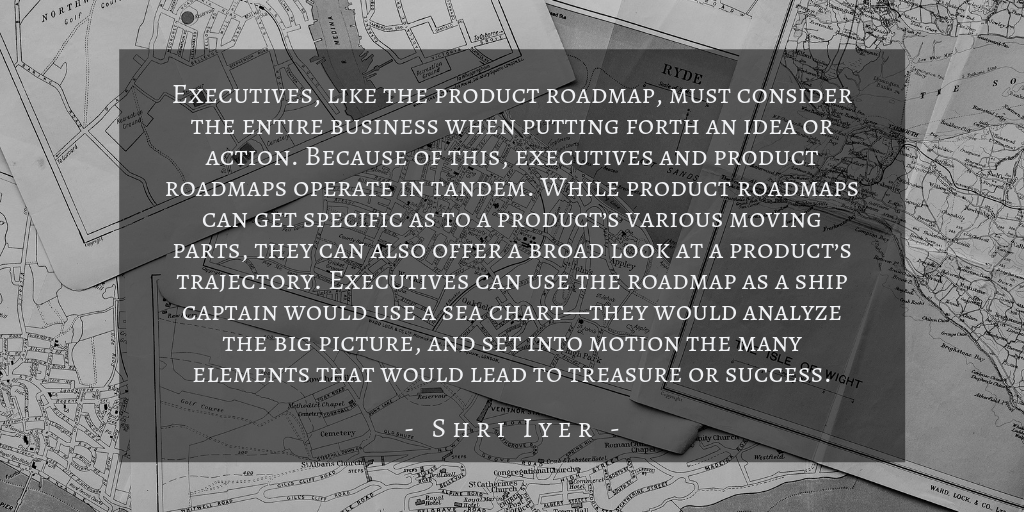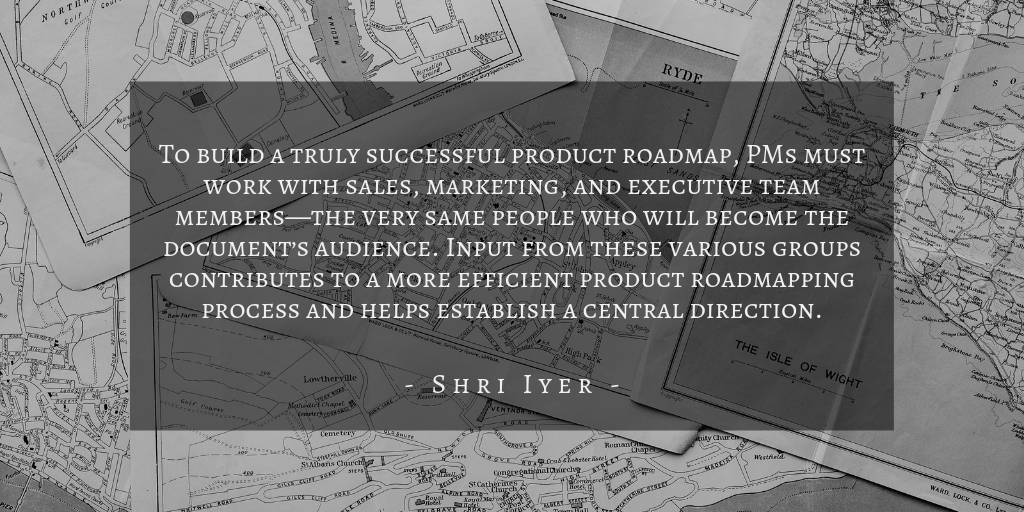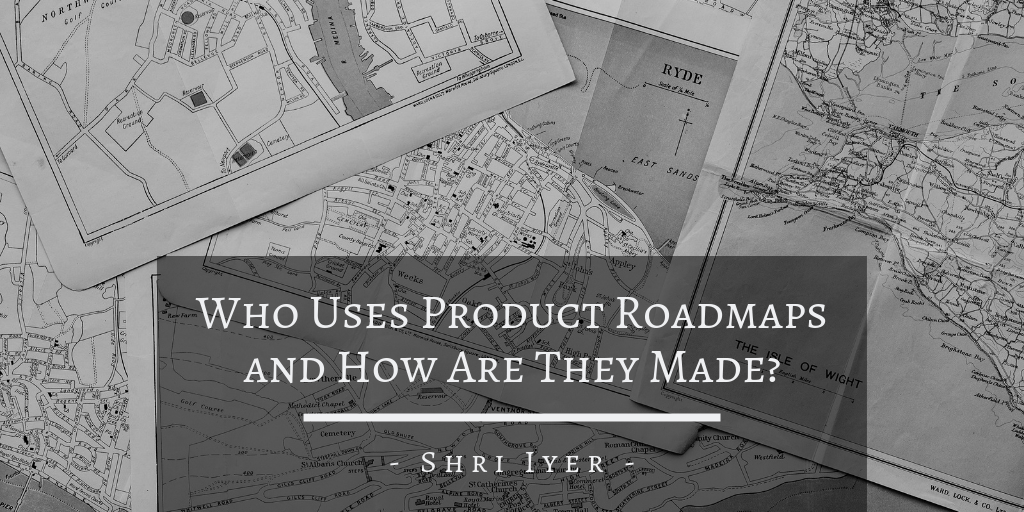One of my previous blog posts defined product roadmapping and explained its importance for Product Managers. However, there is more to the product roadmap that must be considered. For instance, who all benefits from product roadmaps besides PMs? And how are product roadmaps developed?
Who is the Product Roadmap For?

The product roadmap benefits every branch and team of an organization. Recall that product roadmaps demonstrate vision, strategy, goals, and guidelines. These elements are necessary to guide and inspire sales, marketing, and executive employees.
Product roadmaps let sales teams know what can and cannot be immediately changed to fit the needs of a customer. The roadmap can even be incorporated into sales calls and other direct-to-customer interactions to create a well-rounded product pitch. In addition, product roadmaps prepare sales team members for the current and future phases of a product. Because sales is a conduit between customer and product, a solid understanding of the product’s inner workings, history, and future are essential to making the best possible sale.
When it comes to marketing, everything from tweets to webinars can benefit from product roadmap association. The promotional materials put out by marketing teams must compel customers to purchase your products. Just as successful stories have central themes, successful marketing materials draw from the central themes of a product roadmap. Product marketers must use these central themes to create cohesive advertisements for products. Roadmaps offer marketers a look at the core elements of what the product is and why it’s important for customers to know about it.

Executives, like the product roadmap, must consider the entire business when putting forth an idea or action. Because of this, executives and product roadmaps operate in tandem. While product roadmaps can get specific as to a product’s various moving parts, they can also offer a broad look at a product’s trajectory. Executives can use the roadmap as a ship captain would use a sea chart—they would analyze the big picture, and set into motion the many elements that would lead to treasure or success.
Product roadmaps are not just internal benefits, though. Stakeholders can benefit from a well-thought-out product roadmap. It’s particularly important to develop a roadmap that is accessible to customers because, at the end of the day, they’re the people paying for your product or service. As Product Management expert Rich Mironov writes, “customers give us their money, which is the real measure of product success.” Customers give value to products based on whether or not they consider them worth a purchase. Developing a strategy via a product roadmap can explain to customers how the product is being developed, and how that development is keeping the customers in mind.
How is a Product Roadmap Developed?
To build a truly successful product roadmap, PMs must work with sales, marketing, and executive team members—the very same people who will become the document’s audience. Input from these various groups contributes to a more efficient product roadmapping process and helps establish a central direction.

Aha!, a product roadmapping software, lists these key components of product roadmaps:
- Products – The heart of a product roadmap is, naturally, the product. This is the good or service that will be offered to customers.
- Goals – These measurable objectives should be specific enough for certain teams to follow, but broad enough that the whole company can work towards reaching them.
- Initiatives – To balance out the goals, initiatives should be put in place. Initiatives encompass the broad themes of your product vision.
- Releases – Releases, which encompass epics and features, include the package of benefits provided to customers upon a product’s launch.
- Epics – These user stories can be broken down to explore the customer’s perspective of products, services, and needs. Epics are what marketers capitalize on to personalize promotional materials.
- Features – Features include all aspects of a product, including what separates it from the products of competitors.
- User Stories – Smaller-scale than epics, user stories explore what exactly customers want out of a product.
- Time – To give context to goals, initiatives, and releases, time is used in product roadmaps to set deadlines for achieving results.
- Status – To supplement time, status indicates all current progress on various goals and initiatives. Status offers a look at the current state of affairs for a product’s development.
These nine components are developed by a Product Manager’s conversations with various teams across the organization. According to renown blog This is Product Management, all stakeholders should have the chance to offer this key input.
“Responsibility for creating the product roadmap falls solely on the product manager. However, to achieve its stated purpose, the product manager must incorporate input from a number of different sources.”
From there, priorities can be set to establish which goals and initiatives are the most vital for a product’s success.
What Tools Can Be Used to Build Product Roadmaps?
Product Managers are not simply left to their devices when it comes time to build a product roadmap. The influx of business tech has brought with it plenty of product roadmapping software.
Common software includes spreadsheets and presentations. However, each comes with benefits and drawbacks. For instance, spreadsheets help when compiling ideas and features, and make for a great method of organization. However, they lack the visual capabilities of presentations. At the same time, presentations are difficult to update regularly, as the many visual aspects can often take up time to complete. To make up for these shortcomings, software specific to product roadmapping has become increasingly valuable.
When considering a product roadmapping software, PMs should keep in mind their time constraints, level of comfort with developing a product roadmap, and accessibility of software for key stakeholders. The aforementioned Aha! has established itself as one of the world’s top roadmapping software. Boasting self-funded profitability and over 250,000 users, Aha! uses simple but effective layouts to offer ease of design and collaboration. Several product tools, including G Suite, Google Analytics, and Dropbox, can integrate with Aha!
Another roadmapping software is ProductPlan, which merges the simplicity of spreadsheets with the visual aesthetics of presentations. ProductPlan also boasts consistency, a feature that helps all parties and teams understand the plan’s contents. ProductPlan serves as the antithesis to fellow roadmapping software Smartsheet. While ProductPlan focuses on simplicity and visuals, Smartsheet emulates spreadsheets with the goal of consolidating information for ease of accessibility.
In essence, creating a product roadmap is much more involved than most PMs would expect. But, by balancing communication, accessibility, and the right software, PMs can draft successful roadmaps to help a whole organization find its footing.

